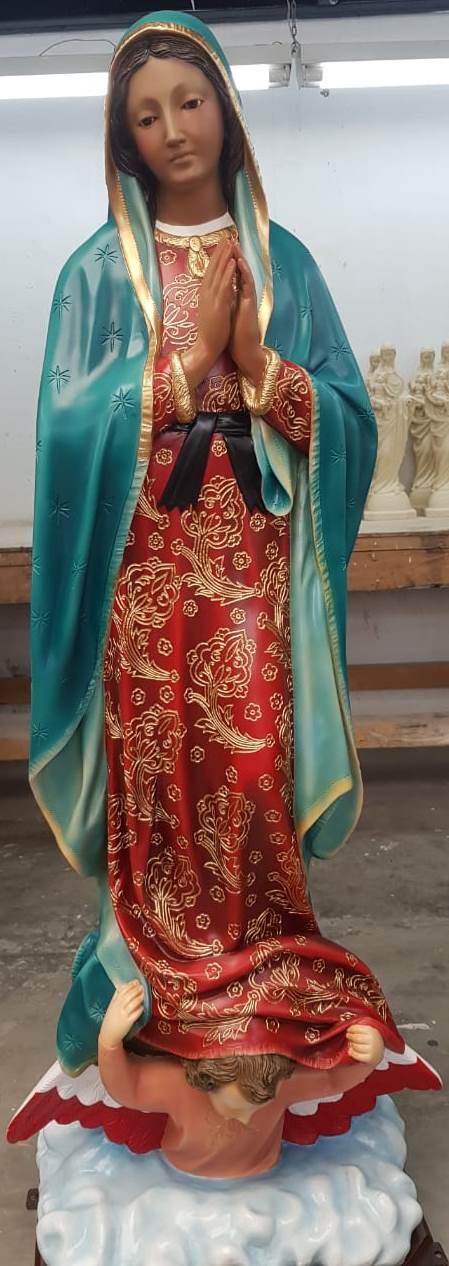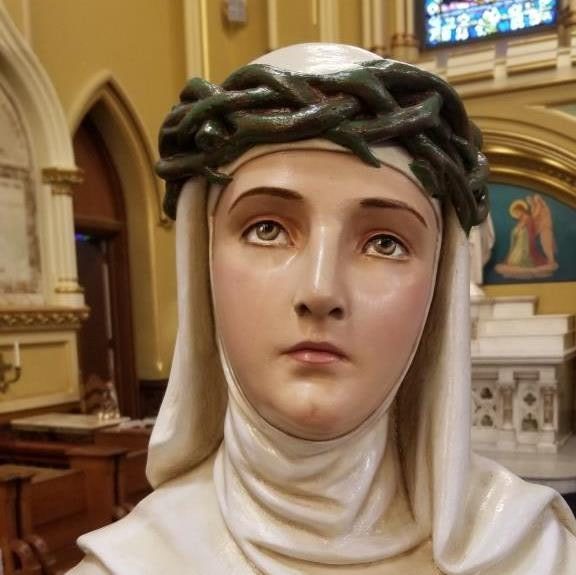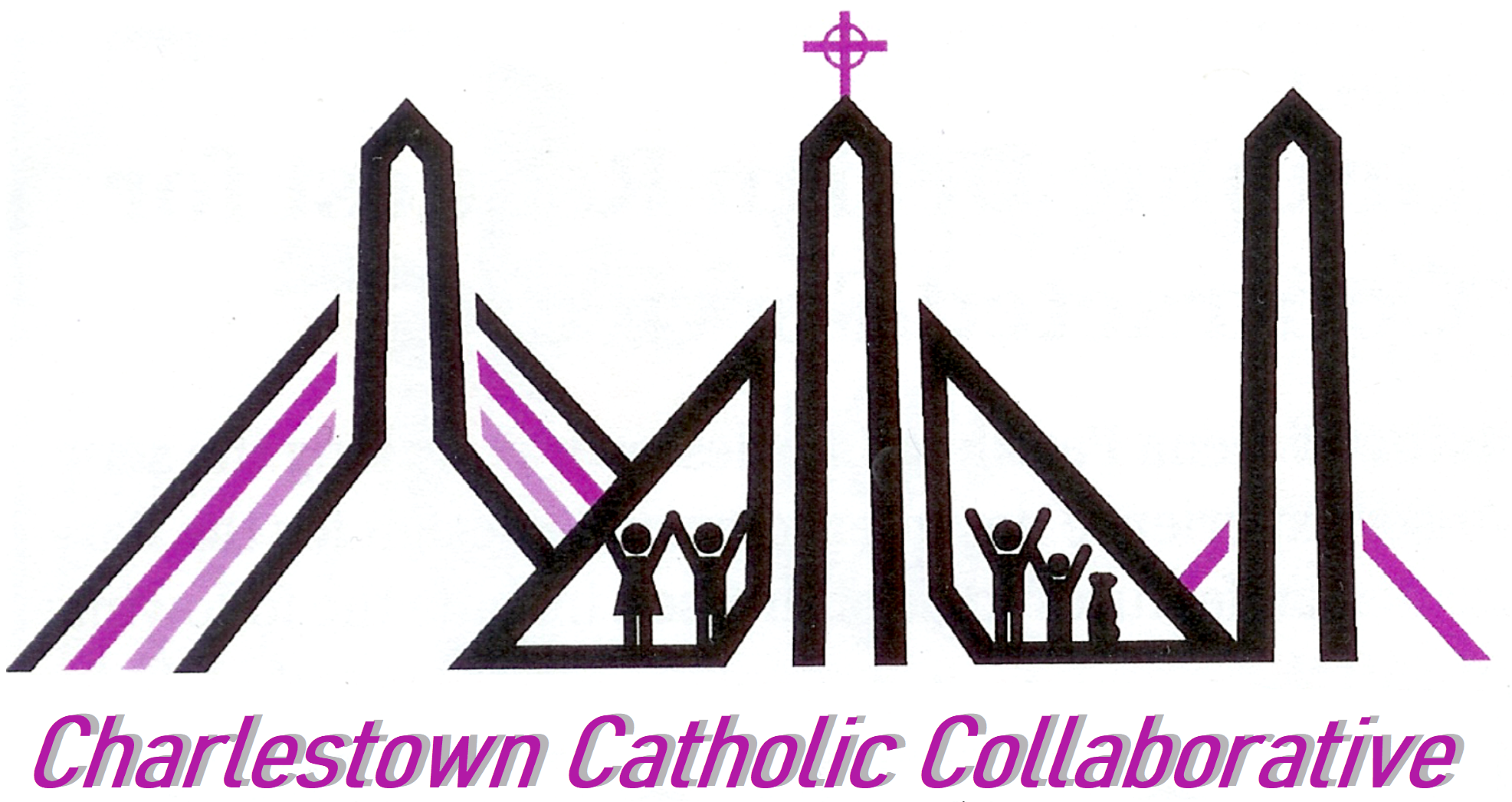Newsletter, June 11, 2021
THE APPARITIONS OF OUR LADY OF GUADALUPE, PATRONESS OF THE AMERICAS
The following account of the five apparitions in three days is based on the oldest written record of the miracle of Our Lady of Guadalupe, the Nican Mopohua, written in Náhuatl about 1540 by Don Antonio Valeriano, one of the first Aztec Indians educated by the Franciscans at the Bishop’s Colégio de la Santa Cruz. An illustration of the apparition event with the signatures of Don Antonio Valeriano and his teacher Father Bernardino de Sahagún with the date 1548 was recently uncovered in a private collection in 1995, now referred to as the Codex 1548. The Codex 1548 has been scientifically determined to be genuine, and substantiates the historical basis of the apparition of Guadalupe.12
The Jesuit Father Miguel Sanchez published the first Spanish work on Guadalupe, Imagen de la Virgen Maria Madre de Dios de Guadalupe in 1648. Brother Luis Lasso de la Vega published in Náhuatl the Nican Mopohua; the Nican Motecpana, an account of fourteen miracles of Our Lady; and other documents in a collection known as Huey Tlamahuizoltica in 1649. The theologian Luis Becerra Tanco published his work on the tradition of Guadalupe in 1675. Finally, the Jesuit professor of theology Francisco de Florencia produced his account of the apparition in 1688. These four writers have been important in the preservation of the tradition of Our Lady of Guadalupe.13
The history of the event is of prime importance. The precipitous conversion of over 8 million Aztec Indians to Catholicism in seven years is highly indicative of the miracle of Guadalupe. Dr. Alan Schreck of Franciscan University has pointed out that great historical movements do not result from non-events.14
The Miracle of Tepeyac
The Aztec Indian Cuauhtlatoatzin, which means “the one who speaks like an eagle,” was born in 1474. He married a girl named Malintzin, and they lived with an uncle near Lake Texcoco. The three were among the few to be baptized in the early days, most likely by Father Toribio in 1525, and given the names Juan Diego and Maria Lucia, and the uncle Juan Bernardino. Maria Lucia was childless, and died a premature death in 1529.
[Stars on Mary’s mantle match the stars in the sky during the winter solstice of 1531, as described by Mario Rojas Sánchez (Source: Manuela Testoni, Reference)
Most important are the black maternity band, a jasmine flower, and a cross that are present in the image. Mary wore a black maternity band, signifying she was with child. At the center of the picture, overlying her womb is a jasmine flower in the shape of an Indian cross, which is the sign of the Divine and the center of the cosmic order to the Aztec. This symbol indicated that the baby Mary carried within her, Jesus Christ, the Word made Flesh, is Divine and the new center of the universe. On the brooch around her neck was a black Christian cross, indicating she is both a bearer and follower of Christ, the Son of God, our Savior, who died on the Cross to save mankind.
In summary, the image signified Mary bringing her Son Christ to the New World through one of their own! As Father Miguel Sanchez noted in 1648, one cannot help but identify Our Lady of Guadalupe with the Woman of the Apocalypse, recorded in the Bible 18 in Revelation 12:
The tilma itself was a cape worn by the Indians of the time, made of ayate, a coarse fiber from agave or the maguey plant. The cape measures 5.5 x 4.6 feet, and is made in two parts sewn by a vertical seam made with thread of the same material. The natural life of the fiber is roughly 20 years to 30 years at most, yet the tilma and the image remain intact after 480 years, in spite of moisture, handling, and candles!
The Immediate Aftermath
Bishop Zumárraga was overwhelmed by the miracle of the tilma, and this time extended his hospitality to Juan Diego and invited him to spend the night. He gently removed the tilma and placed it in his private chapel, where all prayed in thanksgiving for the miracle.
The following day, they set out for Tepeyac, and Juan Diego showed Bishop Zumárraga where Mary had appeared. The Bishop directed that a small sanctuary be erected at the site. The enthusiasm from the event produced so many volunteers that a chapel in Tepeyac was constructed by Christmas Day.
Juan Diego then asked leave of the Bishop that he might see his uncle. The Bishop insisted that Juan Diego be escorted back to his home and then returned to his palace. Juan Diego and Juan Bernardino were joyfully reunited, and both recounted to each other the miraculous events. Juan Diego brought his uncle back to the Bishop’s residence to show him the tilma, and they stayed as guests of the Bishop until Christmas. The convergence of the curious multitude led the Bishop to move the tilma to the Cathedral so that all could marvel and pray.
On December 26, 1531, a solemn procession with the Bishop, Juan Diego, Franciscan priests, and the faithful brought the tilma from the Cathedral to the Chapel at Tepeyac that became known as the Hermitage. Thousands attended the procession. In the excitement, some Indians shot arrows into the air, and one mortally wounded a man in the procession. A priest tended to the wound, and prayers were said to the Virgin, and the man was reported to have been miraculously healed. This only added to the fervor of the procession.
Juan Diego lived in a little house built for him next to the chapel at Tepeyac, and showed the tilma and explained the apparition and its Christian significance over and over to pilgrims who visited the shrine. He died peacefully on May 30, 1548 and was buried at Tepeyac. Bishop Zumárraga died the same year as Juan Diego.
The miracle of Our Lady of Guadalupe led to a tidal wave of conversions. The few missionaries that initially were met with resistance became overwhelmed with baptisms, preaching, and instruction in the faith. An early missionary, the Franciscan Father Toribio de Benavente, recorded in his Historia de Los Indios, published in 1541, that “I have to affirm that at the convent of Quecholac, another priest and myself baptized 14,200 souls in five days. We even placed the Oil of Catechumens and Holy Chrism on all of them.” 19
Recent Developments
The Virgin of Guadalupe is literally intertwined with both the History of the Catholic Church in the new world and of Mexico itself. To mention a few events, the great floods of 1629 claimed 30,000 lives and threatened the destruction of the valley of Mexico, until the waters abated when the image was taken in solemn procession from Tepayac to Mexico City. A horrible plague in the early 1700s claimed the lives of 700,000 people, and, once the Virgin of Guadalupe was declared the Patroness of Mexico on 27 April 1737, the disease dissipated. But before that, as Mexico became mestizo, the union of Spanish born in Mexico and the Indians, La Morenita, or the dark Virgin, became the symbol of the people, and they love her as one of their own.
On November 14, 1921, during a period of Catholic persecution by the Mexican government and the subsequent La Cristiada, a powerful bomb hidden in flowers exploded directly underneath the tilma during High Mass, and destroyed stone and marble in the sanctuary and shattered the stained-glass windows of the Basilica. When the smoke cleared, the congregation was amazed to find that the tilma remained untouched, and the thin protective glass covering was not even cracked, nor was anyone hurt.
Scientific studies of the tilma have been undertaken through the years, which have only served to confirm its supernatural nature. The tilma remains just as vibrant as ever, having never faded. Famous Mexican artists such as Miguel Cabrera (1695-1768) determined that it is impossible for the rough surface of the tilma to support any form of painting. Furthermore, the tilma appeared to embody four different kinds of painting, oil, tempura, watercolor, and fresco, blended in an inexplicable fashion. One of the unusual characteristics of the tilma is that up close the features are unremarkable, but the tone and depth emerge beyond six or seven feet and the image becomes more radiant and photogenic.
The astonishing discovery that reflections of people in Mary’s eyes, perhaps Juan Diego and Bishop Zumarraga or the interpreter Juan Gonzalez, were confirmed by two scientists in 1956. This phenomenon is seen only with human eyes, not in a painting.
Studies by infra-red photography in May of 1979 were undertaken by Philip C. Callahan, a research biophysicist at the University of Florida. He ruled out brush strokes, over-painting, varnish, sizing, or even preliminary drawings by an artist in the body of the image. Damage from the 1629 flood was apparent at the edges of the tilma. He concluded that the original image on the tilma has qualities of color and uses the weave of the cloth in such a way that the image could not be the work of human hands.20
How did Our Lady identify herself? Bishop Zumárraga understood the Spanish name Guadalupe, a Marian shrine in Estremadura, Spain. But Mary spoke Náhuatl to Juan Diego, and some writers suggest that she may have said Coatlaxopeuh or one “who treads on the snake,” recalling Genesis 3:15. On the other hand, Juan Gonzalez, the interpreter present for conversations between Juan Diego, his uncle, and the Bishop, was reported to be fluent in both Náhuatl and Spanish, so any misinterpretation would seem unlikely. Either may be possible, as Mary is our Mother (John 19:25-27) everywhere.
The tilma of Juan Diego is the only known divine image of the Blessed Virgin Mary that exists on our planet!
Seven million people from the Americas visit the Virgin of Guadalupe every year, especially on December 12, the annual celebration of the miracle. If one visits Mexico City, one can plainly see who has the heart of the people. One finds the Virgin of Guadalupe pictured everywhere in Mexico City, in the airport, taxis, bakeries, even on street corners. Our Lady has been the factor that has preserved the Aztec Indians from the cultural disintegration observed with other Indian populations such as in North America.
Popes through the ages have recognized Our Lady of Guadalupe, and Pope John XXIII was the first to call the Virgin Mother of the Americas on October 12, 1961. John Paul II was the first Pope to visit the Guadalupe shrine on January 27, 1979. On January 23, 1999 in his Homily at the Basilica of Our Lady of Guadalupe, Pope John Paul II, referring to all of the Americas as one single continent, called the Virgin of Guadalupe the Mother of America.
Pope John Paul II canonized Juan Diego a Saint on July 31, 2002. Juan Diego certainly deserves sainthood, as he was both humble and obedient to the request of Our Lady. The Catholic Church remains firmly entrenched in Mexico and Latin America, which today are at least 90% Catholic. The Catholic Church of the United States with 77 million Catholics can attribute much of our recent growth to the Hispanic population of North America. 21
REFERENCES : From http://www.maryourmother.net/Guadalupe.html
(Note: Many words in this article have variant spellings, depending on their Náhuatl, Latin, Spanish, or English origin.)
1 Manuela Testoni. Our Lady of Guadalupe: History and Meaning of the Apparitions. (Staten Island, New York: St. Paul-Alba House, 2001), 1-47.
2 Donald Demarest and Coley Taylor. The Dark Virgin: The Book of Our Lady of Guadalupe. (Porter’s Landing, Freeport, Maine: Coley Taylor Publishers, 1956), 1-37.
3 Monsignor Eduardo Chávez. Our Lady of Guadalupe and St. Juan Diego: The Historical Evidence. Translation by Carmen Treviño and Veronica Montaño. (Lanham, Maryland: Rowman & Littlefield, 2006), 1-30, 89-125.
4 Father Virgilio Elizondo. La Morenita: Evangelizer of the Americas. (San Antonio, Texas: Mexican American Cultural Center, 1980), iv-v, 117-121.
5 Elizabeth Boone. The Aztec World. (Washington, DC: St. Remy Press and the Smithsonian Institution Books, 1994), 12-42, 100-122.
6 Francis Johnston. The Wonders of Guadalupe, or El Milagro de Guadalupe. (Rockford, Illinois: Tan Books and Publishers, 1981, 1996), 12-48.
7 Bernal Diaz de Castillo. Discovery and Conquest of Mexico 1517-1521. (New York: Farrar Straus & Cudahy, 1956), 42, 100-122.
8 Carol Berkin, Christopher Miller, Robert Cherny, James Gormly. Making America, Fourth Edition. (Boston: Houghton Mifflin Company, 2006), 35.
9 Carroll WH. Our Lady of Guadalupe and the Conquest of Darkness. (Front Royal, Virginia: Christendom Press, 2002), 21-77.
10 Miguel León-Portilla. Broken Spears – The Aztec Account of the Conquest of Mexico. (Boston: Beacon Press, 1992), 23-36, 115-126.
11 Johnston, The Wonders of Guadalupe, or El Milagro de Guadalupe, 20-22.
12 Don Antonio Valeriano. Nican Mopohua ~1545, reproduced in Testoni, 88-122.
13 Chávez, Our Lady of Guadalupe and St. Juan Diego: The Historical Evidence, 31-52.
14 Alan Schreck PhD. Historical Foundations. Lecture, Franciscan University, Steubenville, Ohio, 2004.
15 Don Antonio Valeriano. Nican Mopohua ~1545, reproduced in Testoni, 88-100.
16 Elizondo, La Morenita: Evangelizer of the Americas, 50-86, 105-121.
17 Carl Anderson and Monsignor Eduardo Chávez. Our Lady of Guadalupe: Mother of the Civilization of Love. (New York: Doubleday, 2009), 44-56, 200.
18 New American Bible, Revised Edition. Catholic Book Publishing, New Jersey, 2011.
19 Johnston, The Wonders of Guadalupe, or El Milagro de Guadalupe, 57, 72-92.
20 Rengers C. Mary of the Americas. (Staten Island, New York: St. Paul-Alba House, 1989), 3-24, 83-94.
21 Chávez, Our Lady of Guadalupe and St. Juan Diego: The Historical Evidence, 143-147.

ST. CATHERINE OF SIENA
DOCTOR OF THE CHURCH AND PATRONESS OF THE UNITED STATES
St. Catherine of Siena was born during the outbreak of the plague in Siena, Italy on March 25, 1347. She was the 25th child born to her mother, although half of her brothers and sisters did not survive childhood. Catherine herself was a twin, but her sister did not survive infancy. Her mother was 40 when she was born. Her father was a cloth dyer.
At the age of 16, Catherine’s sister, Bonaventura, died, leaving her husband as a widower. Catherine’s parents proposed that he marry Catherine as a replacement, but Catherine opposed this. She began fasting and cut her hair short to mar her appearance. Her parents attempted to resist this move to avoid marriage, but they were unsuccessful. Her fasting and her devotion to her family convinced them to relent and allow her to live as she pleased. Catherine once explained that she regarded her father as a representation of Jesus and her mother as Our Lady, and her brothers as the apostles, which helped her to serve them with humility.
Despite Catherine’s religious nature, she did not choose to enter a convent and instead she joined the Third Order of St. Dominic, which allowed her to associate with a religious society while living at home. Fellow Dominican sisters taught St. Catherine how to read. Meanwhile, she lived quietly, isolated within her family home. St. Catherine developed a habit of giving things away and she continually gave away her family’s food and clothing to people in need. She never asked permission to give these things away, and she quietly put up with their criticisms.
Something changed her when she was 21. She described an experience she referred to as her “mystical marriage to Christ.” There are debates over whether or not St. Catherine was given a ring with some claiming she was given a bejeweled ring, and other claiming the ring was made of Jesus’s skin. St. Catherine herself started the rumor of the latter in her writings, but she was known to often claim the ring itself was invisible.
Such mystical experiences change people, and St. Catherine was no exception. In her vision, she was told to reenter public life and to help the poor and sick. She immediately rejoined her family and went into public to help people in need. She often visited hospitals and homes where the poor and sick were found. Her activities quickly attracted followers who helped her in her mission to serve the poor and sick.
St. Catherine was drawn further into the world as she worked, and eventually she began to travel, calling for reform of the Church and for people to confess and to love God totally. She became involved in politics, and was key in working to keep city states loyal to the Pope. She was also credited with helping to start a crusade to the Holy Land. On one occasion, she visited a condemned political prisoner and was credited with saving his soul, which she saw being taken up to heaven at the moment of his death. St. Catherine allegedly was given the stigmata (the wounds of Christ), but like her ring, it was visible only to herself. She took Bl. Raymond of Capua as her confessor and spiritual director.
From 1375 onwards, St. Catherine began dictating letters to scribes. She petitioned for peace and was instrumental in persuading the Pope in Avignon to return to Rome. She became involved in the fractured politics of her time, but was instrumental in restoring the Papacy to Rome and in brokering peace deals during a time of factional conflict and war between the Italian city states.
She also established a monastery for women in 1377 outside of Siena. She is credited with composing over 400 letters, her Dialogue, which is her definitive work, and her prayers. These works are so influential that St. Catherine would later be declared a Doctor of the Church. She is one of the most influential and popular saints in the Church.
By 1380, the 33-year-old mystic had become ill, possibly because of her habit of extreme fasting. Her confessor, Raymond, ordered her to eat, but she replied that she found it difficult to do so, and that possibly she was ill. In January of 1380, her illness accelerated her inability to eat and drink. Within weeks, she was unable to use her legs. She died on April 29, following a stroke just a week prior.
The devotion around Catherine of Siena developed rapidly after her death. She was canonized in 1461, declared patron saint of Rome in 1866, and of Italy (together with Francis of Assisi) in 1939. She was the second woman (only days after Teresa of Ávila) to be declared a “doctor of the Church,” on 4 October 1970 by Pope Paul VI. She was also proclaimed patron saint of Europe in 1999 by Pope John Paul II.
Catherine of Siena is one of the outstanding figures of medieval Catholicism, by the strong influence she has had in the history of the papacy and her extensive authorship. She was behind the return of the Pope from Avignon to Rome, and then carried out many missions entrusted by the pope, something quite rare for a woman in the Middle Ages. Her Dialogue, hundreds of letters, and dozens of prayers also give her a prominent place in the history of Italian literature. St. Catherine’s feast day is April 29. She is the patroness against fire, illness, the United States, Italy, miscarriages, people ridiculed for their faith, sexual temptation, and nurses.
Religious Education Registration for 2021-22 will be released soon! Stay tuned.

Religious Education Registration for 2021-22 will be released soon.
Stay tuned !
